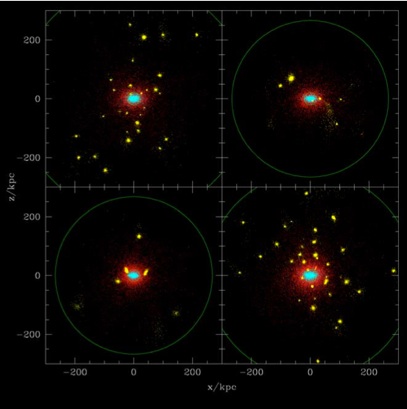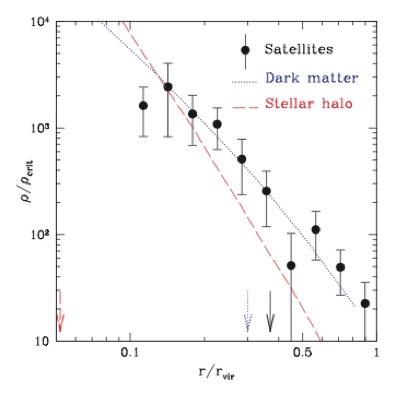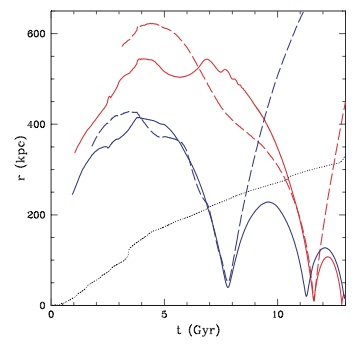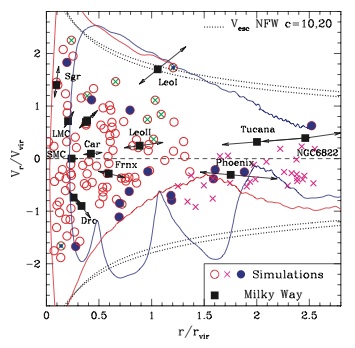Satellite Galaxies

We also explored a bunch of interesting stuff about satellite galaxies. Visit this page
http://www.astro.uvic.ca/~lsales/SatPapers/SatPapers.html to learn more about it.
Or go to our original papers: Sales et al. (2007a) & Sales et al. (2007c) for further details.






In a similar way than the Moon orbits Earth trapped by its gravitational field, small galaxies can revolve around larger ones. These are then ‘satellites’ of the more massive central galaxy. Fig. 1 shows four examples of a simulated satellite galaxy system (yellow clumps) orbiting around their centrals (cyan, red).
Satellite galaxies are more complex than their isolated field counterparts because their properties are linked not only to its own evolution, but also to their response to strong gravitational forces and other environmental effects associated to orbiting within a larger host.
Fig. 1) Four simulated L* galaxies with their stars shown in cyan and red. For each system, we highlight the satellite galaxies in yellow. Number and distribution of satellites considerably varies from halo to halo. The green circle indicates the virial radius of the host.
(Source: Sales et al. 2007a)
Satellite galaxies are not always alone, but sometimes they infall as part of large associations of dwarfs.
Satellites then seem to have their own system of satellites, forming a nested system of substructure.
For example, we believe that the Large Magellanic Cloud (LMC) could have brought a few companions along
when it infalled into the Milky Way’s halo. The Small Magellanic cloud (SMC) is an obvious candidate, but
could other dwarfs of our Galaxy be associated to the LMC?
How do galaxies assemble their satellites?
Satellite galaxies infall throughout the whole life-time of the main halo. But only a handful survive and constitute the satellite system that we observe today. Many, the less lucky ones, are incapable of resisting the gravitational forces and get disrupted. Signatures of this history can be found in the “stellar halos” of galaxies, a dim, extended and diffuse component made of loosely bound stars stripped from satellites that disappeared long time ago.
Infalling together: faint and dark companions of the LMC
(Sales et al. 2011)

We used the set of cosmological simulations of Milky Way like halos from the Aquarius Project to find candidates alike the LMC. Once identified, we followed our best candidate back on time before its infall onto the central halo. We found that hundreds of smaller subhalos indeed came in associated to our simulated LMC. We therefore studied the infall and dynamical evolution of the tidal debree of the LMC group and compare it with present day observations of Milky Way dwarfs.
We found that the common origin for a set of dwarfs induces a spatial correlation on the sky, with most of the group material (and associated subhalos!) living in a well defined region of the sky. And yes, of course it coincides with the projection of the orbit of the LMC-candidate. We can then expect that any dwarf previously associated to the LMC will lie in a polar-ring like distribution.
In Fig. 2 we compare our simulation (gray, black and red) with the observed position of the Milky Way dwarf (blue asterisks). Either in first (left) or second (right) pericenter passage for the LMC, we have several dwarfs fullfilling the requirement for a previous association with the Clouds, among them Carina, Sculptor, Tucana, Fornax, Seg3, Ursa Minor, Draco and some of the Leo’s.
Fig. 2) Sky projection of the simulated LMC group, with grey and black indicating presently unbound and bound material, respectively. Self-bound subhalos are shown in red, and they follow the distribution of the group debree. The panel of the left show the situation for a first-pericenter scenario, where the LMC has just fallen in for the first time into the MW’s potential. The panel on the right show the situation for a second pericenter, still reproducing the observed proper-motions of the Cloud. We overlap in blue the positions of the dwarf galaxies in the Milky Way.
Notice that the LMC debree follows the orbit of the LMC candidate, shown in green.
(Source: Sales et al. 2011)
Our work also showed that coincidence of the position on the sky is not enough to guarantee membership.
Instead, the angular momentum of the group debree is well conserved despite the triaxiality of the halo. Therefore, dwarfs are required to have the right position on the sky, lie at the same distance and with the same velocity than the material stripped from the simulated LMC group. Such a requirement can be summarized by plotting the direction of the angular momentum of the simulated group and the observed dwarfs (see Fig. 3). We find that all should strongly cluster around the orbital pole of the LMC itself. With this discrimination, only SMC, Fornax and Carina, survive as possible associations to the LMC. The proper motions of smaller dwarfs like the faint Leo’s or Seg 3 will be crucial to confirm or dismiss their memberships.
An interesting corollary of our paper is that many ultra-faint dwarfs are expected to be in the area of the sky close to the LMC (see Fig. 2). We look forward to observational campaigns like SkyMapper to survey the surroundings of the Cloud in the Southern skies.
Fig. 3) Orbital poles of the simulated LMC group (gray/black) and its associated subhalos (red). Most of the material clusters strongly on a small region of the sky around the orbital pole of the LMC. In blue we overplot the orbital pole of some dwarfs candidates to a previous LMC association. Only SMC, Fornax and Carina so far seem to meet the requirements.
(Source: Sales et al. 2011)
Infalling together: satellite interactions and ejections
(Sales et al. 2007b)
If you want to read more about this, please refer to Sales et al. (2011) or look at one of my related talks (slides/podcast) at the “First Galaxies and Faint Dwarfs meeting”, KITP on February 2012.

Satellites are good tracers of the underlying potential
One reason to study satellite galaxies is that they behave like massless test-particles in the host potential well. Therefore, we use their positions and kinematics as tracers of the unseen dark matter halo they inhabit. They are very important observable tracers beyond the inner few tens of kiloparsecs from the primary galaxy. Other examples are globular clusters and planetary nebulae, but they are usually much more concentrated towards the inner regions.
Satellites are therefore our best extended tracers of host dark matter halos.
Funny things can happen when several dwarfs venture together close to the host halo.
During my PhD work we used hydrodynamical simulations of the formation of 8 ~L* galaxies and explored the details on the formation and evolution of their satellite system. We discovered that sometimes, faint dwarfs that were once within a central host halo, can be found out to very large distances, apparently unrelated to the main galaxy.
These objects are rare, since satellites are expected to maintain or diminish their apocenter passages, not to increase them. This gain of energy is, according to our studies, due to the tidal disruption of an infalling dwarf group or pair. In cases like those shown in Fig. 4, the lightest member of the pair gets ejected of the primary-satellite system and will never return.
The kinematics of such orbits is odd and they show typically quite large radial velocities. We argue that such mechanism could explain the origin of distant, apparently isolated dwarf spheroidals wondering in the outskirts of the Milky Way and Local Group, such as LeoI, Phoenix, Cetus or Tucana (see Fig. 5).
Read more on our original paper, Sales et al. (2007b).
Fig. 4) Orbits for two simulated satellite pairs with a escaping member (dashed line). For both systems, the escapee is the lightest member of the pair and gets propelled onto a very radial orbit after the interaction.
(Source: Sales et al. 2007b)
Fig. 5) In the distance (r) radial velocity plane (Vr) escapees show up as outliers, having too large a radial velocity given their distance (see for instance red-circled dot close to Leo I). Also, if they escaped suffiently long ago, they are located at very large distances (more than 2 virial radius). The red/blue curves show the evolution of the escapees from Fig. 4. Notice that the simulated satellites lie close to LeoI, Tucana or NGC6822, providing a possible scenario for their odd kinematics and morphologies.
(Source: Sales et al. 2007b)
We tested this assumption of satellites being fair tracers of the host dark matter potential by using hydrodynamical simulations as well as semi-analytical catalogs from the Millennium Run project.
Fig. 6 shows that satellites indeed trace the dark matter radial distribution and kinematics. These are excellent news for observational folks, who now use statistical samples of observed satellite systems to measure the mass, distribution and velocity of the host halos.

Fig. 6) Radial distribution (left) and 3D velocity dispersions (right) of the satellite system of simulated galaxies. Blue dotted line show the host dark matter halo, which always provide a reasonable fit to the satellite distributions. Satellites are thus faithful tracers of the host potential.
(Source: Sales et al. 2007a)